|
Harlequin was made by the Homer Laughlin China Company from 1936 until 1964 in twelve colors. It was an inexpensive alternative to Fiesta and primarily sold through F. W. Woolworth five and dime stores. Homer Laughlin made many dinnerware lines made for Woolworth which were given a treatment number with a "W-" prefix. Harlequin's was W-336.
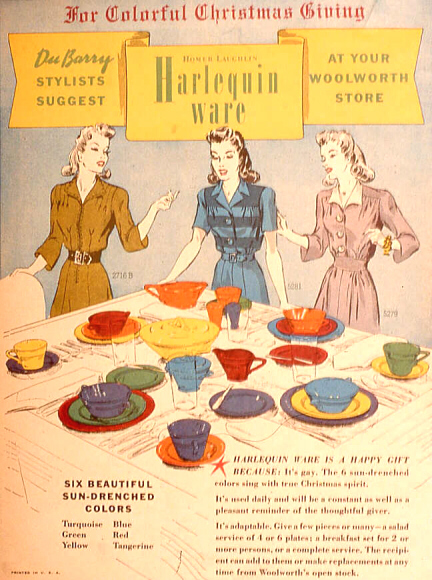
Harlequin advertisement from the late 1930s |
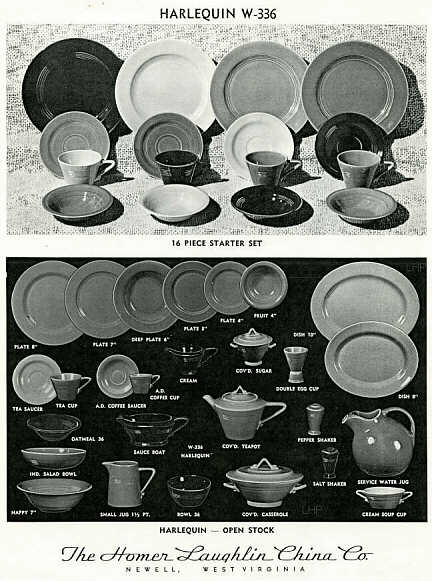
Harlequin cut sheet from the 1950s |
On May 15th and 16th, 1936, designer Frederick Rhead wrote about a new line of dinnerware that would go on to become Harlequin:
Going over material for new colored glaze shapes and model outline. J.M. Wells - new shape for Syndicate stores. Colored glazes similar to Fiesta practice.
In June, nine different designs of 9-inch plates and test glazes were made. One of the first colors was the bright Harlequin yellow which Rhead commented on as, "The finest yellow I have ever seen on tableware." On June 18, 1936, he wrote on color development: "...Assembled possible colors. Find that green is weak .. to arrive at middle green on the same scale as stain on W. S. George greens rather than greens of the "Victoria" - a yellow green type. J, M. Wells states that the final selection will range from 3 to 4 colors, but that we should plan a comprehensive series. Shape is to be dipped in each glaze." After several glazes were developed, samples were made.
On July 10, 1936 Rhead wrote that one of the sample plates had been approved by Woolworth's and was released into production. Further, drawings were made of the teacup and this would, as Rhead wrote, "determine character of hollowware and other
items."
In mid July 1936, two styles of teacups were modeled based on Rheads' sketches. The first had a curved body and the other conical. Both had curved handles, but alternates were made with angular handles for the cone shape cup. From here two styles of hollowware were crafted: the "convex" shape - the curved rounded body, and the "straight sided" shape or cone shape. While the style of the hollowware had not yet been decided upon, several flat pieces were being produced, namely a "rolled top" nappy and fruit cup from July and the 10" plate and 8" deep plate from the first week of August.
On August 1, 1936, Rhead noted, "Woolworth colored glaze [teacups] out [of kilns]. Also extra plates. Bad dipping and green too transparent. The conical cup is much better than the convex cup and the glaze behaves much better..."
The casserole was the next piece made. At this point, the style of hollowware still had not been determined. First came the convex casserole with a ball shaped handles and finials followed by the straight sided version. The convex sugar was the next item modeled. On August 13, Rhead commented on the progression of the hollowware: Trouble with new casserole [convex shape]. Knobs are not finished properly. Working on a new type of lug and on the straight sided shape. Hollowware is proceeding slowly. Rhead did in fact make "lugs" for the convex casserole and at least one example is known to exist in the Harlequin blue (mauve) glaze. Another change was made to both casseroles with the
elimination of the foot.

Sketches for the convex style of Harlequin hollowware - teacup, casserole, and sugar.
|
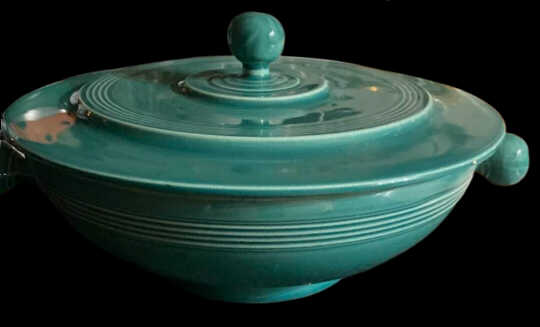
|
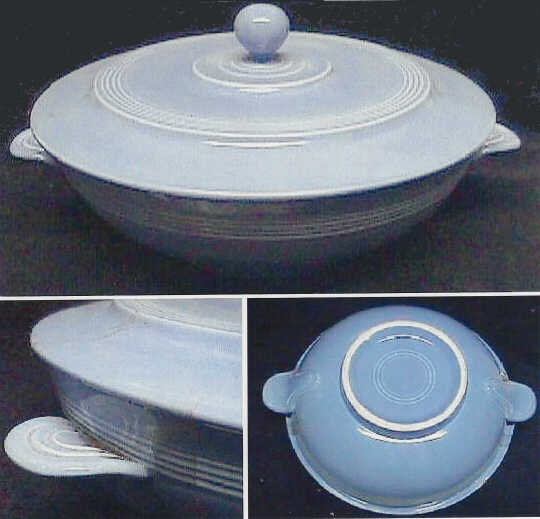
|
Top: 1st convex prototype with knob handles and finial in spruce
Courtesy: Frank Russo
Right: 2nd convex prototype with tab handles in blue
|
During the last week of August, the glaze trials were much better and a style of hollowware was finally accepted as Rhead noted on the 28th, ...J. M. Wells approved new conical casserole. Not to change manufacturing... convex shape is out. The latest green is O.K. Type not to be changed. With the conical shapes as the bassis, the rest of the hollowware was modeled. The last piece created in August was the creamer. This would have been the first style of what collectors call the "high lip" creamer. The first piece modeled at the beginning of September was the covered sugar.
On September 17, 1936, the teacup's handle was finally chosen as was the color assortment of maroon, yellow, blue, and green. On the 21st, the line was officially named Harlequin and more pieces were released into production.
By the end of September 1936, Harlequin was in production with four colors. The original assortment included:
- 10" plate
- 9" plate
- 7" plate
- 6" plate
- Teacup
- Saucer
- Oval Baker
- Sugar
- Creamer
- Fruit Cup
- Nappy
- Shakers
- Double Egg Cup
- Deep Plate
- Casserole
|
The line remained largely unchanged for the next several months with one major exception - the creamer. On October 27, 1936, Rhead wrote: Released Harlequin jug, new model #700 No. 3 Harlequin cream. New model to replace old shape. This would have been the second high lip creamer with a longer spout. In an entry dated February 9, 1937, yet another creamer was requested: Letters from Woolworth.. The Harlequin creamer - The new spout pours all right, but they want it more graceful. To work out new adjustment. Towards the end of February, the new creamer was modeled and released into production on March 3rd.
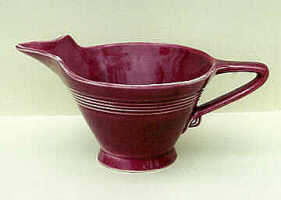
High lip, short spout
Sept - Oct 1936 |
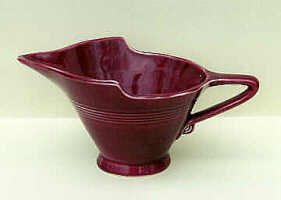
High lip, long spout
Oct 1936 - March 1937 |
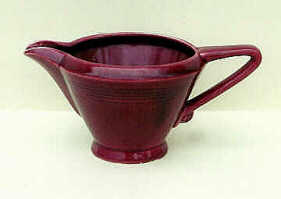
Regular Creamer
March 1937 - 1964 |
For several years after its introduction, pieces were often added to Harlequin.
| 1937
|
| March
| 11" platter, 5 11/16" fruit cup
|
| Sept.
| Demitasse cup and saucer
|
| 1938
| | Jan
| Regular ashtray, 13" platter, tumbler, single egg cup
| | Feb
| Nut dish, marmalade, teapot, cream soup cup
| | April
| 22-oz jug, sauceboat
| | Nov
| Novelty creamer
| | 1939
| | Jan
| Ind. creamer
| | August
| Basket weave ashtray
| | Sept
| Salad bowl, ashtray saucer
| | 1940
| | Jan
| Syrup
| | March
| 4 3/4" fruit bowl (not released into production)
| | April
| Candlesticks, relish dish, 6 3/8" oatmeal
| | Nov
| 36s bowl
|
Several pieces were remodeled in the 1940s for the automatic jigger (as were many other lines) but there were no new additions until 1955 with the jumbo or "large" cup and corresponding 6 7/8" saucer. (For more on the Jumbo cup, see section on Epicure.)
In late 1942, production of dinnerware was cut back. Many patterns and more exotic accessory shapes were discontinued. In some cases, entire lines (namely Modern Farmer) were retired all together. With other Homer Laughlin lines and shapes, assortments can be easy to figure out by referencing vintage advertisements, but since Harlequin was carried by only Woolworth's (which almost never issued brochures), figuring out exact dates when an item was discontinued can be difficult. Generally, production dates for each piece can be figured out based on available colors.
Harlequin started out with four colors, red, green, blue, and yellow. Collectors call yellow "Harlequin yellow" to avoid confusion with the slightly darker yellow used with Fiesta. The blue has been called Mauve Blue for many years due to the Harlequin coverage in Sharon and Bob Huxford's Fiesta books. When this shade is used by other companies such as Knowles, W. S. George, etc., it is almost always called "Medium Blue." Many collectors have started calling this glaze, "Harlequin blue." The red, a.k.a. maroon or burgundy was sometimes called "Crimson" by Rhead and in one vintage ad was called "Wine" by Woolworth's. The green is usually called spruce, again, from Huxford's Fiesta books.
The next two colors added to Harlequin were tangerine (Fiesta red) and turquoise. This must have been done sometime between March 1937 and January 1940 since the high lip creamers are found only in the four original glazes and relish trays, first made in January 1940, always have turquoise bases and usually a red insert.
Three colors were discontinued in the 1940s; maroon, spruce and tangerine (Fiesta red). On May 29, 1941, Rhead notes how the Harlequin and Fiesta glazes were selling:
Colored glazes selling as follows
| Harlequin
| Fiesta
| Yellow
| Tangerine [red]
|
| Tangerine
| Yellow
|
| Blue [mauve]
| Turquoise
|
| Turquoise
| Blue [cobalt]
|
| Crimson [maroon]
| Ivory
|
| Green [spruce]
| Green [light]
| | |
Soon after compiling the list above, he starts work on other glazes for Harlequin. On July 2, 1941, he wrote about two salmon and one gray glaze. Evidentially, maroon was replaced by one of the salmon's which collectors call rose. (Maroon was also used in Tango and was dropped in favor of Fiesta red.)
The next color dropped was spruce green. Unlike maroon, a new glaze wasn't developed. Instead, the green used in Fiesta at the time, "light green", was picked up as a replacement. This must have happened at the same time many pieces were being discontinued since it has been well documented that certain pieces are very difficult to find in light green. These include the candlesticks, single egg cups, and nut dish. When found in light green, their prices are much higher than those in other colors.
Fiesta red, or tangerine, was no longer offered in 1943. It contained uranium and the government seized control of the element due to W.W.II. After the loss of Fiesta red, Harlequin's color assortment was reduced to: Harlequin yellow, Harlequin blue, turquoise, rose, and light green.
In 1951, Harlequin blue and light green were discontinued. Harlequin yellow, turquoise, and rose were joined with forest green, gray, and chartreuse. This would be the first time the color assortments for Fiesta and Harlequin matched.
In 1959, the color line up changed for the last time when rose, gray, forest green, and chartreuse were dropped. Harlequin yellow and turquoise continued production along with a new green glaze, called "medium green" by collectors. Fiesta red was reintroduced at this time. More pieces were discontinued when this color changed occurred and are hard to find in medium green: the service water jug, 22-oz jug, and novelty creamer to name a few.
The Harlequin line was finally discontinued in 1964 after almost thirty years as a Woolworth's exclusive.
See also sections on:
|